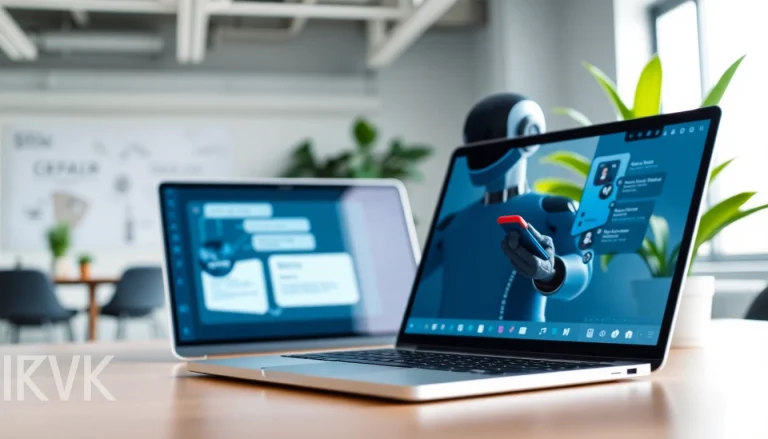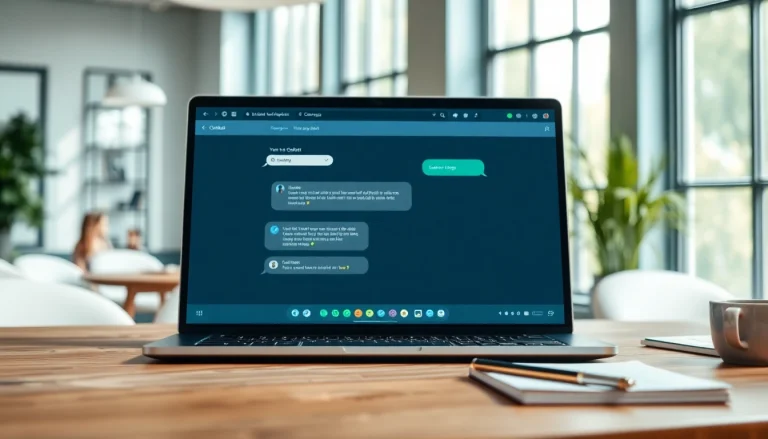
Understanding the Basics of Website Chatbots
What is a Website Chatbot?
A website chatbot is an artificial intelligence (AI) application that simulates human interaction. It serves as an automated tool that assists users through online conversations, either via text or voice. These chatbots are integrated into websites, messaging platforms, or mobile applications, providing a conversational interface to enhance user engagement. By understanding user queries and responding accordingly, chatbots can cater to customer needs in real-time. The growing sophistication of chatbots has made them a critical component for businesses looking to streamline communication and enhance customer support.
The Importance of Website Chatbots in Modern Business
In today’s digital landscape, businesses face increasing pressure to deliver exceptional customer experiences. Website chatbots have emerged as essential tools for engaging customers while minimizing operational costs. With the ability to provide instant responses, chatbots address customer inquiries around the clock, eliminate wait times, and improve satisfaction rates. Moreover, they gather valuable data on user behavior, allowing companies to optimize their services and tailor engagement strategies effectively.
Different Types of Website Chatbots Explained
Website chatbots can be categorized into two main types: rule-based and AI-driven chatbots. Rule-based chatbots rely on predefined workflows and scripts to guide conversations. They can perform straightforward tasks such as answering FAQs or providing information on services. AI-driven chatbots, on the other hand, utilize natural language processing (NLP) to understand user intent and adapt their responses accordingly. This flexibility allows them to handle more complex queries and deliver a personalized user experience. Choosing the right type largely depends on the specific needs and goals of a business.
Key Benefits of Implementing a Website Chatbot
24/7 Customer Support and Availability
One of the most compelling advantages of website chatbots is their ability to offer round-the-clock support. Unlike human agents, chatbots do not require breaks or sleep, enabling them to be available at any hour. This continuous availability means customers can receive assistance whenever they need it, resulting in enhanced satisfaction and loyalty. Furthermore, chatbots can manage repetitive inquiries that would otherwise burden human agents, allowing staff to focus on more complex or sensitive issues.
Enhancing User Experience through Personalized Interactions
Personalization is crucial to creating a positive user experience. Modern chatbots leverage data analysis to tailor conversations based on user preferences and previous interactions. For instance, when a returning customer initiates a chat, the bot can recall past purchases or previous interactions, allowing it to offer personalized recommendations or relevant support. This level of engagement not only improves customer satisfaction but also fosters brand loyalty and increases conversion rates.
Cost-Effectiveness of Website Chatbots for Businesses
Integrating a website chatbot can significantly reduce operational costs. By automating routine tasks, companies can decrease the need for extensive customer service staff, leading to savings on salaries, training, and infrastructure. Additionally, chatbots can handle multiple inquiries simultaneously, which means that businesses can improve efficiency without proportionally increasing their labor force. This cost-effectiveness, combined with improved customer service, makes chatbots an attractive investment for organizations of all sizes.
How to Choose the Right Website Chatbot for Your Needs
Identifying Your Business Requirements
Before investing in a chatbot solution, it is essential to clearly define your business’s specific requirements. This includes understanding the primary goals you wish to achieve, such as improving customer support, increasing lead generation, or offering troubleshooting assistance. Consider your target audience, common inquiries, and preferred communication channels. By identifying these needs, you can more effectively evaluate chatbot options that align with your objectives.
Comparing Features and Functionalities of Different Chatbots
Not all chatbots are created equal. When comparing options, analyze the features and functionalities that each solution offers. Key aspects to consider include integration capabilities with existing software, scalability, ease of use, and the ability to support advanced AI functionalities, such as natural language understanding and sentiment analysis. Investigating these aspects will enable you to select a chatbot that not only meets your immediate needs but also has the potential to grow with your business.
Evaluating User Feedback and Case Studies
User feedback and real-world case studies provide valuable insights into the performance of different chatbot solutions. Check reviews and ratings from previous clients or users of the chatbot software. Additionally, research case studies that demonstrate how specific chatbots have improved customer experiences, boosted sales, or streamlined operations for similar businesses. This due diligence will help you gauge the effectiveness of the technology you are considering.
Best Practices for Website Chatbot Implementation
Designing a User-Friendly Chatbot Interface
An intuitive and user-friendly interface is critical for a successful chatbot implementation. The design should facilitate seamless interactions, minimizing user frustration. Key elements to consider include a clear and concise layout, easily recognizable buttons, and a conversational tone. Moreover, ensuring that the chatbot can be easily accessed from various devices and browsers will help maximize user engagement.
Integrating with Other Customer Service Tools
To maximize the potential of your website chatbot, consider integrating it with your existing customer relationship management (CRM) systems, helpdesk tools, and analytics platforms. This connectivity enables the chatbot to access and utilize valuable customer data to enhance interactions further. It also allows for streamlined communication across channels, ensuring that user inquiries handled by the chatbot can be seamlessly transitioned to human agents when necessary.
Regular Testing and Updates for Optimal Performance
Once your chatbot is live, it’s essential to conduct regular testing to ensure it operates as intended. Monitoring user interactions and gathering feedback will help identify potential areas for improvement. Additionally, bots should be routinely updated to incorporate new information, addresses updated business practices, and adapt to changing customer needs. This ongoing commitment to refinement will enhance chatbot performance and user satisfaction.
Measuring the Success of Your Website Chatbot
Key Performance Indicators (KPIs) to Track
Measuring the effectiveness of your chatbot involves tracking specific key performance indicators (KPIs). Important metrics include user engagement rates, average response time, resolution rates, and customer satisfaction scores. Analyzing these metrics will reveal insights into how well the chatbot meets its objectives and where improvements may be needed. Setting clear benchmarks for each KPI can facilitate ongoing optimization of the chatbot’s performance.
Analyzing User Interaction and Feedback
In addition to quantitative metrics, qualitative feedback from users provides invaluable insights into their experiences with the chatbot. Encourage users to share their thoughts on the interactions they have had, and analyze common themes in that feedback. Observing user behavior, such as conversation patterns and drop-off rates, can also illuminate bottlenecks in the user journey, enabling you to make data-driven adjustments to the chatbot’s functionalities.
Continuous Improvement Through A/B Testing
A/B testing is a powerful technique for optimizing chatbot interactions. By running controlled experiments with variations in responses, interface design, and suggestions, you can assess which elements resonate best with users. This iterative approach fosters continuous improvement, ensuring that the chatbot evolves in line with user preferences and business goals. Over time, effective A/B testing can lead to significantly enhanced user experiences and higher engagement rates.





